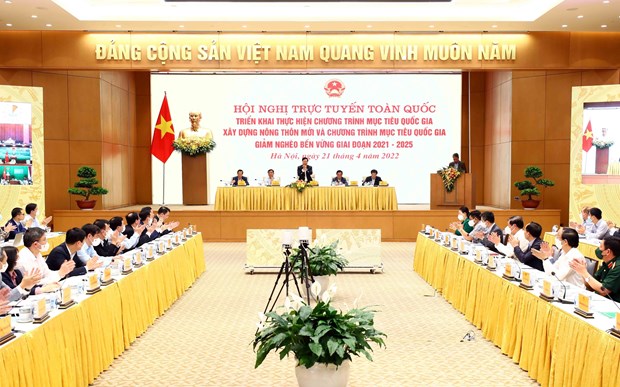Vietnam aims for 80 percent of communes recognised as new-style rural areas by 2025
At least 80 percent of communes nationwide are expected to be recognised as new-style rural areas by 2025, according to the national target programe on new-style rural area building.
 At the conference (Photo: VNA)
At the conference (Photo: VNA)The programme and another on sustainable poverty reduction, both set for 2021-2025, were the main topics of a national conference held virtually on April 21.
Of the expected new-style rural communes, around 40 percent are projected to win the advanced new-style rural area title, and at least 10 percent will be exemplary new-style rural areas.
Notably, the average income of rural residents will increase by at least 1.5 times compared with 2020.
Meanwhile, half of cities and districts will secure the new-rural area title and fulfill the target of new-style rural area building, of which 20 percent will reach the advanced and model levels.
Funding for the national target programme on new-style rural area building is estimated at 196.33 trillion VND (8.54 billion USD) at the lowest, with 156.7 trillion VND coming from the local budget.
Meanwhile, the programme on sustainable poverty reduction targets a reduction of 1-1.5 percent in the multidimensional poverty rate. With seven projects and 11 sub-projects, it is expected to cost at least 75 trillion VND, of which 12.6 trillion VND is being sourced from the local budget.
At the meeting, localities called for the early allocation of capital from the central budget, saying ministries and agencies should quickly issue guiding documents and specific criteria for the implementation of the programmes.
In his remarks, Deputy Prime Minister Pham Binh Minh, head of the central steering committee for national target programmes, asked localities to raise public awareness of the two programmes, together with another on socio-economic development in ethnic minority-inhabited and mountainous areas in the 2021-2025 period.
Assigning specific tasks to ministries, agencies and localities, Minh emphasised that all projects within the programmes must be built, assessed and approved in line with the Law on Public Investment and other relevant legal regulations.
Legal financial resources, including official development assistance (ODA), non-refundable aid and capital from different economic sectors, should be maximised during the implementation of the programmes, he said.
The official also ordered the application of information technology and digital transformation in the communication work as well as in management to effectively deploy the programmes with their progress ensured./.













